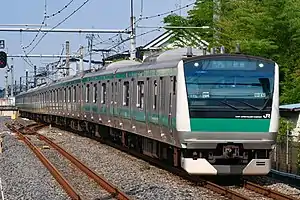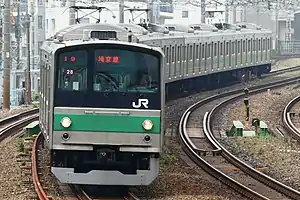| Kawagoe Line | |||
|---|---|---|---|
 The Kawagoe Line E233-7000 series EMU | |||
| Overview | |||
| Native name | 川越線 | ||
| Owner | |||
| Locale | Saitama Prefecture | ||
| Termini | |||
| Stations | 11 | ||
| Service | |||
| Type | Heavy rail | ||
| Depot(s) | Kawagoe | ||
| History | |||
| Opened | 1940 | ||
| Technical | |||
| Line length | 30.6 km (19.0 mi) | ||
| Track gauge | 1,067 mm (3 ft 6 in) | ||
| Electrification | 1,500 V DC overhead catenary | ||
| |||
Route map | ||||||||||||||||||||||||||||||||||||||||||||||||||||||||||||||||||||||||||||||||||||||||||||||||||||||||||||||||||||||||||||||||||||||||||||||||||||||||||||||||||||||||||||||||||||||||||||||||||||||||||||||||||||||||||||||||||||||||||||||
|---|---|---|---|---|---|---|---|---|---|---|---|---|---|---|---|---|---|---|---|---|---|---|---|---|---|---|---|---|---|---|---|---|---|---|---|---|---|---|---|---|---|---|---|---|---|---|---|---|---|---|---|---|---|---|---|---|---|---|---|---|---|---|---|---|---|---|---|---|---|---|---|---|---|---|---|---|---|---|---|---|---|---|---|---|---|---|---|---|---|---|---|---|---|---|---|---|---|---|---|---|---|---|---|---|---|---|---|---|---|---|---|---|---|---|---|---|---|---|---|---|---|---|---|---|---|---|---|---|---|---|---|---|---|---|---|---|---|---|---|---|---|---|---|---|---|---|---|---|---|---|---|---|---|---|---|---|---|---|---|---|---|---|---|---|---|---|---|---|---|---|---|---|---|---|---|---|---|---|---|---|---|---|---|---|---|---|---|---|---|---|---|---|---|---|---|---|---|---|---|---|---|---|---|---|---|---|---|---|---|---|---|---|---|---|---|---|---|---|---|---|---|---|---|---|---|---|---|---|---|---|---|---|---|---|---|---|---|---|
| ||||||||||||||||||||||||||||||||||||||||||||||||||||||||||||||||||||||||||||||||||||||||||||||||||||||||||||||||||||||||||||||||||||||||||||||||||||||||||||||||||||||||||||||||||||||||||||||||||||||||||||||||||||||||||||||||||||||||||||||
The Kawagoe Line (Japanese: 川越線, romanized: Kawagoe-sen) is a railway line in Japan operated by the East Japan Railway Company (JR East), which connects the cities of Saitama, Kawagoe, and Hidaka in Saitama Prefecture. The main transfer stations on the line are Ōmiya, Kawagoe, and Komagawa.
Services
The eastern section between Kawagoe and Ōmiya operates as an extension of the Saikyō Line from central Tokyo, with most trains traveling through to/from Ōsaki and on to/from Shin-Kiba via the Rinkai Line. On the western section between Kawagoe and Komagawa, about half of all trains travel through to/from Hachiōji via the Hachikō Line.
Except for a few rush-hour trains that start and terminate at Minami-Furuya, all eastbound trains from Komagawa and westbound trains from Ōmiya terminate at Kawagoe. Passengers wishing to travel beyond Kawagoe must change trains there.
Station list
- All stations are located in Saitama Prefecture.
- Passengers bound for Ōmiya or Komagawa must change trains at Kawagoe. However, during early mornings and evenings, some trains leaving Kawagoe depot provide service from Minami-Furuya to Komagawa.
- All rapid or commuter rapid trains to/from the Saikyo Line stop at every station on the Kawagoe Line.
- Trains can pass each other at stations marked "∥", "∨", and "◇"; they cannot pass at stations marked "|".
Saitama – Kawagoe
| Station | Japanese | Distance (km) | Transfers | Track layout | Location | |||
|---|---|---|---|---|---|---|---|---|
| Between stations |
Total | |||||||
| Through services to/from Shin-Kiba on the Rinkai Line via the Saikyo Line
Through service to Ebina via the Saikyo Line, Shōnan-Shinjuku Line, and Sōtetsu Shin-Yokohama Line | ||||||||
| Ōmiya | 大宮 | - | 0.0 | from Ōsaki 36.9 |
|
∥ | Ōmiya-ku | Saitama |
| Nisshin | 日進 | 3.7 | 3.7 | 40.6 | ∨ | Kita-ku | ||
| Nishi-Ōmiya | 西大宮 | 2.6 | 6.3 | 43.2 | ◇ | Nishi-ku | ||
| Sashiōgi | 指扇 | 1.4 | 7.7 | 44.6 | ◇ | |||
| Minami-Furuya | 南古谷 | 4.7 | 12.4 | 49.3 | ◇ | Kawagoe | ||
| Kawagoe | 川越 | 3.7 | 16.1 | 53.0 |
|
◇ | ||
Kawagoe – Komagawa
| Station | Japanese | Distance (km) | Transfers | Track layout | Location | |||
|---|---|---|---|---|---|---|---|---|
| Between stations |
Total | |||||||
| Kawagoe | 川越 | 3.7 | 16.1 | from Hachiōji 45.6 |
|
◇ | Kawagoe | |
| Nishi-Kawagoe | 西川越 | 2.6 | 18.7 | 43.0 | | | |||
| Matoba | 的場 | 2.2 | 20.9 | 40.8 | ◇ | |||
| Kasahata | 笠幡 | 2.9 | 23.8 | 37.9 | | | |||
| Musashi-Takahagi | 武蔵高萩 | 3.2 | 27.0 | 34.7 | ◇ | Hidaka | ||
| Komagawa | 高麗川 | 3.6 | 30.6 | 31.1 | ■ Hachiko Line (through service) | ◇ | ||
| Through services to/from Hachiōji on the Hachiko Line | ||||||||
Rolling stock
- E233-7000 series 10-car EMUs x 38 (Kawagoe Line/Saikyo Line/TWR Rinkai Line services since 30 June 2013)
- 209-3500 series 4-car EMUs x 5 (Kawagoe Line/Hachiko Line services since 7 May 2018)
- E231-3000 series 4-car EMUs x 6 (Kawagoe Line/Hachiko Line services since 19 February 2018)
- TWR 70-000 series 10-car EMUs x 8 (Kawagoe Line/Saikyo Line/TWR Rinkai Line services)
The electric multiple unit (EMU) fleet used on Kawagoe Line services is based at Kawagoe Depot (close to Minami-Furuya Station).[1] The first of a fleet of 31 new 10-car E233-7000 series sets were introduced on Saikyo Line, Kawagoe Line, and Rinkai Line services between Kawagoe and Shin-Kiba from 30 June 2013, displacing all but one of the fleet of 205 series EMUs.[2][3] The sole 205 series set was withdrawn from service in October 2016, then in 2019 seven more E233-7000 series sets entered service, bringing the total number of E233-7000's to 38.
From 2017, former E231-0 series ten-car sets based at Mitaka Depot for use on Chuo-Sobu Line services were reformed and converted to become four-car E231-3000 series sets based at Kawagoe for use on Kawagoe Line and Hachiko Line services.[4] The first set entered revenue service on the line on 19 February 2018.[5]
From 2018, former 209-500 series ten-car sets based at Mitaka Depot for use on Chuo-Sobu Line services were reformed and converted to become four-car 209-3500 series sets based at Kawagoe for use on Kawagoe Line and Hachiko Line services.[6]
 An E233-7000 series EMU January 2022
An E233-7000 series EMU January 2022 A 209-3500 series in June 2018
A 209-3500 series in June 2018 E231-3000 series in March 2018
E231-3000 series in March 2018 A TWR 70-000 series EMU in June 2018
A TWR 70-000 series EMU in June 2018
Rolling stock previously used
- 9600 class steam locomotives (until September 1969)
- KiHa 07 diesel cars (from 1955)
- KiHa 15 DMUs
- KiHa 20 DMUs
- KiHa 35 DMUs (1964 – September 1985)
- 103-3000 series EMUs (from March 1985 until October 2005)[7]
- 103-3500 series EMU (from March 1996 until March 2005)[7]
- 205 series 10-car EMUs x 32 (Kawagoe Line/Saikyo Line/TWR Rinkai Line services until October 2016)
- 205-3000 series 4-car EMUs x 5 (Kawagoe Line/Hachikō Line services until July 2018)
- 209-3000 series 4-car EMUs x 4 (Kawagoe Line/Hachiko Line services from March 1996 until February 2019)
- 209-3100 series 4-car EMUs x 2 (Kawagoe Line/Hachiko Line services from 17 April 2005[7] until January 2022)
As of October 2016, all Saikyo Line 205 series sets have been removed from service.[8]
 A Hachiko Line KiHa 35 series DMU
A Hachiko Line KiHa 35 series DMU A Kawagoe Line 103-3000 series EMU, June 2004
A Kawagoe Line 103-3000 series EMU, June 2004 A Kawagoe Line 103-3500 series EMU, June 2004
A Kawagoe Line 103-3500 series EMU, June 2004 A Saikyo Line 205 series EMU in September 2016
A Saikyo Line 205 series EMU in September 2016 A 205-3000 series EMU in April 2017
A 205-3000 series EMU in April 2017 A 209-3000 series EMU in April 2017
A 209-3000 series EMU in April 2017 A 209-3100 series EMU in April 2017
A 209-3100 series EMU in April 2017
History
Line opening
A line linking Ōmiya with Kawagoe and continuing to the Hachikō Line at Komagawa was first proposed in March 1920. Construction work started in September 1935, with the line opening on 22 July 1940.[9]
Switch to diesel
Services were initially steam hauled, but diesel multiple unit trains were introduced from 1 June 1950. The final steam-hauled passenger train ran on 30 September 1969.[9]
Electrification
The line was electrified (1,500 V DC) from 30 September 1985, and through running commenced to and from the Saikyō Line, which opened at the same time. The tracks were doubled between Ōmiya to Nisshin, and a new EMU depot was opened close to Minami-Furuya Station. A special "Kawagoe Line Diesel Sayonara" train ran on the line on 3 November 1985.[9]
Hachikō Line through services
Through services between Kawagoe and Hachiōji on the Hachikō Line began on 16 March 1996 following the electrification of the southern section of the Hachikō Line between Komagawa and Hachiōji.[9]
References
- ↑ JR電車編成表 2012冬 [JR EMU Formations – Winter 2012]. Japan: JRR. October 2011. pp. 66–67. ISBN 978-4-330-25611-5.
- ↑ 秋田新幹線用車両と埼京線・横浜線用車両の新造について [Akita Shinkansen, Saikyo Line, and Yokohama Line new train details] (PDF) (in Japanese). JR East. 10 April 2012. Retrieved 10 April 2012.
- ↑ 新型車両で快適に 埼京・川越線、30日から導入 [Comfortable new trains to be introduced on Saikyo/Kawagoe Line from 30th] (in Japanese). Japan: The Saitama Shimbun. 7 June 2013. Archived from the original on 9 June 2013. Retrieved 7 June 2013.
- ↑ E231系3000番台4両が配給輸送される [E231-3000 series 4-car set transferred]. Japan Railfan Magazine Online (in Japanese). Japan: Koyusha Co., Ltd. 29 November 2017. Archived from the original on 29 November 2017. Retrieved 29 November 2017.
- ↑ 八高線用の209系3500番台が試運転 [Hachiko Line 209-3500 series undergoes test-running]. Japan Railfan Magazine Online (in Japanese). Japan: Koyusha Co., Ltd. 21 February 2018. Archived from the original on 21 February 2018. Retrieved 21 February 2018.
- ↑ 八高線用の209系3500番台が配給輸送される [Hachiko Line 209-3500 series transferred]. Japan Railfan Magazine Online (in Japanese). Japan: Koyusha Co., Ltd. 19 January 2018. Archived from the original on 20 January 2018. Retrieved 20 January 2018.
- 1 2 3 "川越線に209系3100代を投入 103系を置換え" [209-3100 series introduced on Kawagoe Line – Replacing 103 series]. Railway Journal. Japan: Tetsudō Journal. 39 (465): 106. July 2005.
- ↑ JR車両ファイル2016 [JR Rolling Stock File 2016]. Japan Railfan Magazine (in Japanese). Vol. 56, no. 663. Japan: Koyusha Co., Ltd. July 2016. p. 34.
- 1 2 3 4 歴史でめぐる鉄道全路線 国鉄・JR NO.45 埼京線・八高線・川越線・武蔵野線・京葉線 [Railway Line History – JNR/JR No. 45: Saikyo Line, Hachiko Line, Kawagoe Line, Musashino Line, Keiyo Line]. Japan: Asahi Shimbun Publications Inc. June 2010. EAN 4910222710600.
External links
- Stations of the Kawagoe Line (JR East) (in Japanese)
